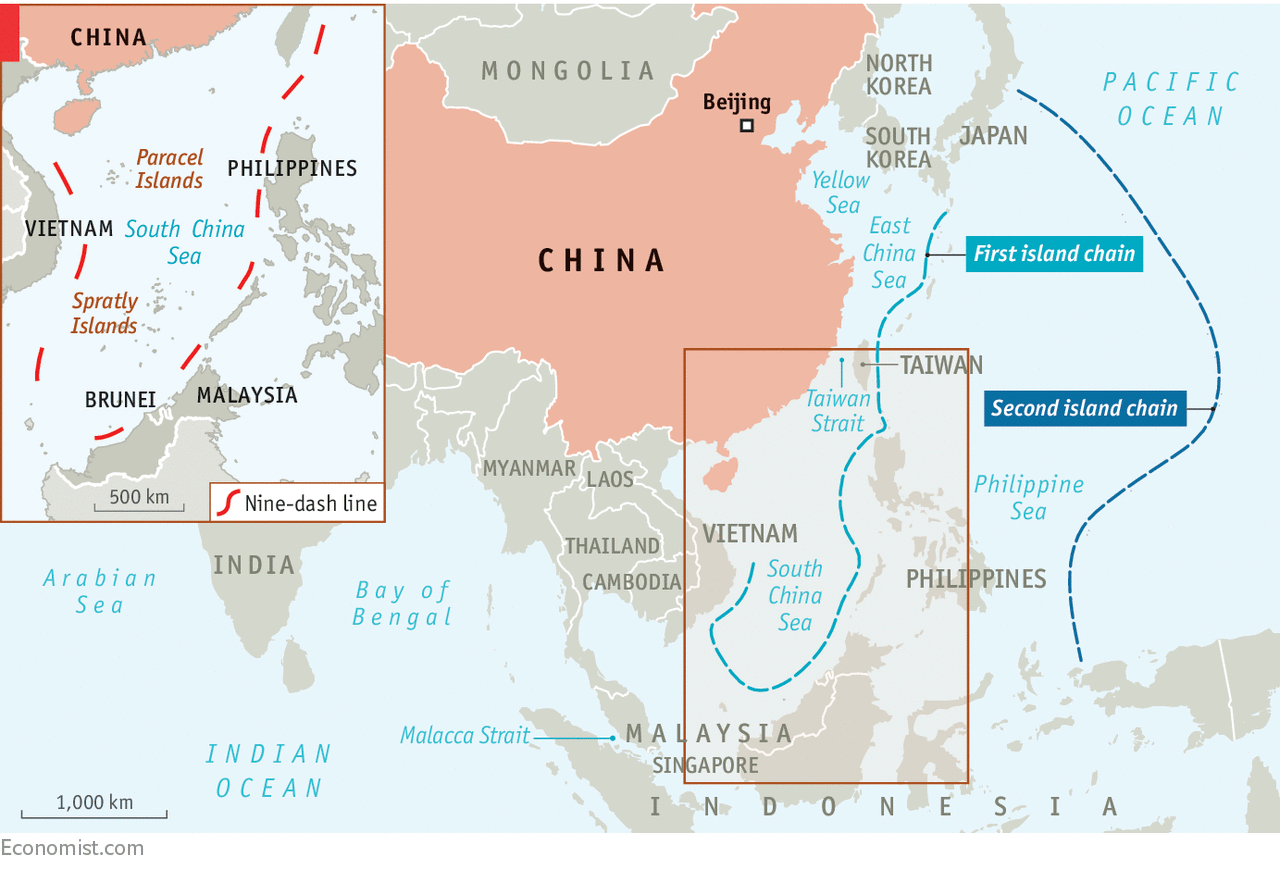 A KEY ELEMENT of Chinese strategy is to “know your enemy”. The generals who worked at the Academy of Military Science in Beijing studied every aspect of America’s “revolution in military affairs” in the 1980s, driven by advances in microprocessors, sensors and communications. They concluded that although China was well placed to exploit the new technologies to create its own version of “informationised” warfare, it would not be in a position to challenge American military might directly until the middle of the 21st century. To do so sooner would be suicidal. H.R. McMaster, Donald Trump’s national security adviser, once observed: “There are two ways to fight the United States: asymmetrically and stupid.”
A KEY ELEMENT of Chinese strategy is to “know your enemy”. The generals who worked at the Academy of Military Science in Beijing studied every aspect of America’s “revolution in military affairs” in the 1980s, driven by advances in microprocessors, sensors and communications. They concluded that although China was well placed to exploit the new technologies to create its own version of “informationised” warfare, it would not be in a position to challenge American military might directly until the middle of the 21st century. To do so sooner would be suicidal. H.R. McMaster, Donald Trump’s national security adviser, once observed: “There are two ways to fight the United States: asymmetrically and stupid.”
Accordingly, the Chinese generals and their Russian counterparts, who had been equally impressed by the precision-strike capabilities that America demonstrated in the first Gulf war, sought ways to reap some of the political and territorial gains of military victory without crossing the threshold of overt warfare. They came up with the concept of a “grey zone” in which powers such as Russia, China and Iran can exercise aggression and coercion without exposing themselves to the risks of escalation and severe retribution. Mark Galeotti of the Institute of International Relations in Prague describes this approach as “guerrilla geopolitics”.
A key aspect of grey-zone challenges is that they should be sufficiently ambiguous to leave targets unsure how to respond
A key aspect of grey-zone challenges is that they should be sufficiently ambiguous to leave targets unsure how to respond. If they do too little, they will face a series of small but cumulatively significant defeats. If they do too much, they risk being held responsible for reckless escalation. As Hal Brands of the Philadelphia-based Foreign Policy Research Institute argues, grey-zone tactics are “frequently shrouded in misinformation and deception, and are often conducted in ways that are meant to make proper attribution of the responsible party difficult to nail down”. They are drawn from a comprehensive toolset that ranges from cyber attacks to propaganda and subversion, economic blackmail and sabotage, sponsorship of proxy forces and creeping military expansionism.
The clearest recent cases of grey-zone challenges are Russia’s intervention in Ukraine, China’s assertive behaviour in the South and East China Seas and Iran’s use of proxy militias to establish an arc of influence from Iraq through Syria into Lebanon. All three countries recognise and to some extent fear superior Western military power. But all of them also see vulnerabilities that they can exploit.
A Russian grey-zone strategy is to undermine faith in Western institutions and encourage populist movements by meddling in elections and using bots and trolls on social media to fan grievances and prejudice. The result, the Kremlin hopes, will sap the West’s capacity to respond resolutely to acts that defy international norms. If Russian cyber attacks did help to get Donald Trump elected, they have been astonishingly successful in their broader aim, if not in the narrower one of relieving Ukraine-related sanctions.
There is no evidence of Chinese complicity in Russian-style hacker attacks on the West, but officially sanctioned trolls send out hundreds of millions of social-media posts every year attacking Western values and pumping up nationalist sentiment. The advent of Mr Trump serves Chinese aims too. His repudiation of the Trans-Pacific Partnership removed a challenge to China’s regional economic hegemony, a key objective of its grey-zone strategy. And the American president’s hostility to free trade and his decision to withdraw from the Paris climate accord has allowed Xi Jinping to cast himself, improbably, as a defender of the international order.
As for Iran, America’s inconsistency and lack of a long-term strategy in the Middle East has offered boundless opportunities for grey-zone advantage-seeking. Both George W. Bush and Barack Obama in their different ways allowed Iran to use a combination of soft religious and hard power through well-trained and equipped Shia militias to turn first Iraq and then most of Syria into something resembling Iranian satrapies.
Grey-zone success depends on patience and an ability to blend together all the instruments of state power in ways that pluralistic, democratic societies find harder to achieve. Hybrid warfare may be as old as warfare itself, but in Ukraine Russia provided a near-textbook example of it in its modern form, using a variety of techniques: sophisticated propaganda that stirred up local grievances and legitimised military action; cyber attacks on power grids and disruption of gas supplies; covert or deniable operations, such as sending “little green men” (soldiers in unmarked green army uniforms) into Crimea and providing weapons and military support to separatist irregular forces; the threat of “escalating to de-escalate”, even including limited use of nuclear weapons. All this dissuaded the West from even contemplating a military response of any kind. Whenever the sale of defensive weapons to Ukraine was mooted in Washington, Mr Putin threatened to expand and intensify a war in which he claimed not to be a participant.
Russia’s objective is not to “win” a war in Ukraine but to reverse the country’s attempt to move out of Russia’s orbit; to discourage other countries, such as Belarus, from trying anything similar; and to stoke nationalist and anti-Western sentiment at home. The effort has not been without cost. Sanctions have hurt. Making Crimea a viable entity will take time and lots of money. Most important of all, NATO has rediscovered some of its sense of purpose. But neither Mr Putin nor any likely successor would hesitate to apply the same hybrid-warfare techniques in the future should the need arise.
China’s grey-zone campaign to assert uncontested control over the South China Sea and jurisdiction over disputed islands in the East China Sea has been going on for much longer, and has turned a darker shade of grey over time as the country’s confidence and power has grown. Since 2009, when China submitted a map to the United Nations showing a “nine-dash line” that supported its claim to “indisputable sovereignty” over 90% of the South China Sea (see map), it has applied what James Holmes of the US Naval War College has described as “small-stick diplomacy” (as opposed to the big stick of conventional naval power), using its highly capable coastguard and militiamen embedded in its fishing fleet to push other littoral states out of waters to which it claims ancestral rights.

It has been able to cow most of its neighbours into sulky acquiescence while avoiding a direct confrontation with American naval ships, which did not want to risk a major incident over what China portrayed as maritime policing. When in 2013 China took its provocations a step further by sending civil engineers to the Spratly and Paracel archipelagoes to construct artificial islands, Xi Jinping said China had no intention of militarising them. But in 2017, satellite images released by the Centre for Strategic and International Studies showed shelters for missile batteries and military radar installations being constructed on the Fiery Cross, Mischief and Subi Reefs in the Spratly Islands. Fighter jets will be on their way next. Mr Holmes suggests that such strategic gains cannot now be reversed short of open warfare, which means they will almost certainly not be. Unlike traditional warfare, grey-zone strategies will not produce decisive results within a defined time frame. But both China and Russia have demonstrated that hybrid warfare, if not pushed too far, can achieve lasting, if not costless, results.
Hybrid warfare is hard to deter unless the target state itself resorts to hybrid strategies. Mr Brands sees no reason why America and its allies cannot play that game too. America has potent economic and financial tools at its disposal, along with an arsenal of cyber weapons, expert special forces, a network of alliances and unmatched soft power. But the West tends to think about conflict in a binary way: you are either at war or at peace; you win or you lose. Its adversaries are more attuned to conflict somewhere between war and peace, and to blurring distinctions between civil and military assets in pursuit of their goals. So for opponents of the rules-based system, the grey zone will remain fertile territory.
No comments:
Post a Comment